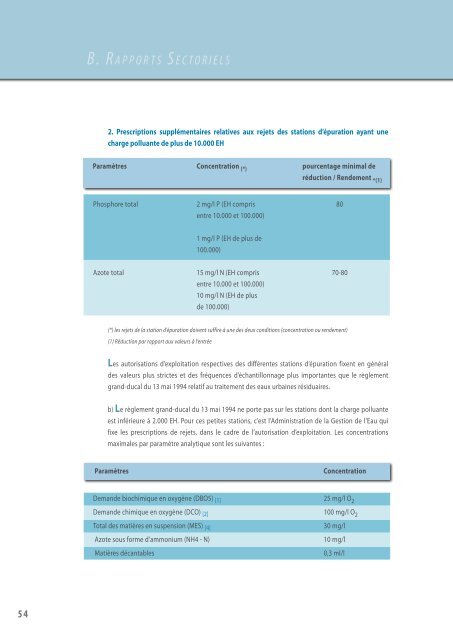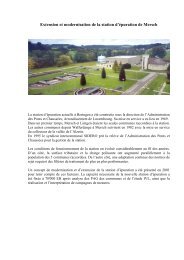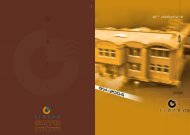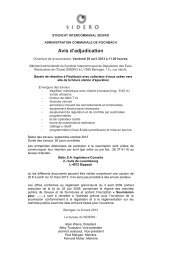Consultation du rapport de gestion. - SIDERO
Consultation du rapport de gestion. - SIDERO
Consultation du rapport de gestion. - SIDERO
Create successful ePaper yourself
Turn your PDF publications into a flip-book with our unique Google optimized e-Paper software.
B . R a p p o r t s S e c t o r i e l s<br />
2. Prescriptions supplémentaires relatives aux rejets <strong>de</strong>s stations d’épuration ayant une<br />
charge polluante <strong>de</strong> plus <strong>de</strong> 10.000 EH<br />
Paramètres Concentration (*) pourcentage minimal <strong>de</strong><br />
ré<strong>du</strong>ction / Ren<strong>de</strong>ment *(1)<br />
Phosphore total 2 mg/l P (EH compris 80<br />
entre 10.000 et 100.000)<br />
1 mg/l P (EH <strong>de</strong> plus <strong>de</strong><br />
100.000)<br />
Azote total 15 mg/l N (EH compris 70-80<br />
entre 10.000 et 100.000)<br />
10 mg/l N (EH <strong>de</strong> plus<br />
<strong>de</strong> 100.000)<br />
(*) les rejets <strong>de</strong> la station d’épuration doivent suffire à une <strong>de</strong>s <strong>de</strong>ux conditions (concentration ou ren<strong>de</strong>ment)<br />
(1) Ré<strong>du</strong>ction par <strong>rapport</strong> aux valeurs à l’entrée<br />
Les autorisations d’exploitation respectives <strong>de</strong>s différentes stations d’épuration fixent en général<br />
<strong>de</strong>s valeurs plus strictes et <strong>de</strong>s fréquences d’échantillonnage plus importantes que le règlement<br />
grand-<strong>du</strong>cal <strong>du</strong> 13 mai 1994 relatif au traitement <strong>de</strong>s eaux urbaines rési<strong>du</strong>aires.<br />
b) Le règlement grand-<strong>du</strong>cal <strong>du</strong> 13 mai 1994 ne porte pas sur les stations dont la charge polluante<br />
est inférieure à 2.000 EH. Pour ces petites stations, c’est l’Administration <strong>de</strong> la Gestion <strong>de</strong> l’Eau qui<br />
fixe les prescriptions <strong>de</strong> rejets, dans le cadre <strong>de</strong> l’autorisation d’exploitation. Les concentrations<br />
maximales par paramètre analytique sont les suivantes :<br />
Paramètres<br />
Concentration<br />
Deman<strong>de</strong> biochimique en oxygène (DBO5) [1] 25 mg/l O 2<br />
Deman<strong>de</strong> chimique en oxygène (DCO) [2] 100 mg/l O 2<br />
Total <strong>de</strong>s matières en suspension (MES) [4]<br />
Azote sous forme d’ammonium (NH4 - N)<br />
Matières décantables<br />
30 mg/l<br />
10 mg/l<br />
0,3 ml/l<br />
5 4






